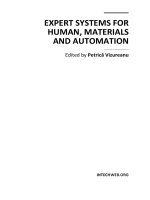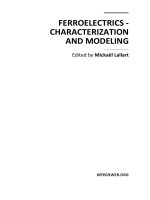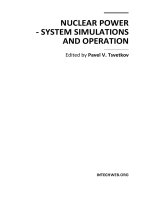Code of Standard Practice for Steel Buildings and Bridges Part 1 pdf
Bạn đang xem bản rút gọn của tài liệu. Xem và tải ngay bản đầy đủ của tài liệu tại đây (20.12 KB, 9 trang )
Code of Standard Practice
for Steel Buildings
and Bridges
March 7, 2000
Supersedes the June 10, 1992 AISC Code of Standard Practice
for Steel Buildings and Bridges and all previous versions.
Prepared by the American Institute of Steel Construction, Inc. under
the direction of the AISC Committee on the Code of Standard
Practice and approved by the AISC Board of Directors.
AMERICAN INSTITUTE OF STEEL CONSTRUCTION, INC.
One East Wacker Drive, Suite 3100, Chicago, Illinois 60601-2001
Copyright © 2000
by
American Institute of Steel Construction, Inc.
All rights reserved. This book or any part thereof
must not be reproduced in any form without
the written permission of the publisher.
The information presented in this publication has been prepared in
accordance with recognized engineering principles and is for general
information only. While it is believed to be accurate, this information
should not be used or relied upon for any specific application without
competent professional examination and verification of its accuracy,
suitability and applicability by a licensed engineer, architect or other
professional. The publication of the material contained herein is not
intended as a representation or warranty on the part of the American
Institute of Steel Construction, Inc. or of any other person named
herein, that this information is suitable for any general or particular
use or of freedom from infringement of any patent or patents. Anyone
making use of this information assumes all liability arising from such
use.
Caution must be exercised when relying upon other specifications and
codes developed by other bodies and incorporated by reference herein
since such material may be modified or amended from time to time
subsequent to the printing of this edition. The American Institute of
Steel Construction, Inc. bears no responsibility for such material other
than to refer to it and incorporate it by reference at the time of the ini-
tial publication of this edition.
Printed in the United States of America
Code of Standard Practice for Steel Buildings and Bridges, March 7, 2000
AMERICAN INSTITUTE OF STEEL CONSTRUCTION
ii
PREFACE
As in any industry, trade practices have developed among those that are
involved in the design, purchase, fabrication and erection of structural
steel. This Code provides a useful framework for a common understanding
of the acceptable standards when contracting for structural steel. As such,
it is useful for owners, architects, engineers, general contractors, construc-
tion managers, fabricators, steel detailers, erectors and others that are asso-
ciated with construction in structural steel. Unless specific provisions to
the contrary are contained in the contract documents, the existing trade
practices that are contained herein are considered to be the standard cus-
tom and usage of the industry and are thereby incorporated into the rela-
tionships between the parties to a contract.
The Symbols and Glossary are an integral part of this Code. In
many sections of this Code, a non-mandatory Commentary has been pre-
pared to provide background and further explanation for the corresponding
Code provisions. The user is encouraged to consult it.
Since the first edition of this Code was published in 1924, AISC
has continuously surveyed the structural steel design community and con-
struction industry to determine standard trade practices. Since then, this
Code has been periodically updated to reflect new and changing technolo-
gy and industry practices.
This edition is the fifth complete revision of this Code since it was
first published. It is the result of the deliberations of a fair and balanced
Committee, the membership of which included six structural engineers,
two architects, one general contractor, seven fabricators, one steel detailer,
three erectors and one attorney. The following major changes have been
made in this revision:
• Commentary information, when available, has been placed immediate-
ly following its corresponding Code provisions.
• The use of the term “Owner” throughout this Code has been generally
(but not completely) eliminated, where appropriate. Instead, one or
both of the terms “Owner’s Designated Representative for Design” and
“Owner’s Designated Representative for Construction” has been used.
• Both U.S. customary units and metric units have been provided. See
Section 1.3.
Code of Standard Practice for Steel Buildings and Bridges, March 7, 2000
AMERICAN INSTITUTE OF STEEL CONSTRUCTION
iii
• Requirements for existing structures have been added to cover demoli-
tion and shoring, protection against damage, surveying or field dimen-
sioning and hazardous materials.
• The classifications of materials in Section 2 have been editorially
revised and expanded.
• Provisions for the resolution of discrepancies have been added in
Section 3.3.
• Also in Section 3.3, the order of precedence of contract documents has
been changed for simplicity and to reflect current practices.
• Provisions for fast-track project delivery have been added in Section
3.6.
• The responsibilities of the various entities involved in the shop and
erection drawing approval process have been simplified and clarified in
Section 4.
• Issues regarding the use of design drawings by the fabricator and/or the
erector are now covered in Section 4.3.
• The permissible variation from theoretical curvature for a curved mem-
ber is now covered in Section 6.4.2.
• Provisions have been added in Section 6.4.5 to cover permissible vari-
ations in camber for fabricated trusses.
• Section 6.5 has been editorially restructured and substantively modi-
fied to recognize that the majority of steel in building structures need
not be primed or painted.
• Coverage of bearing devices has been revised: installation of bearing
devices is now covered in Section 7.6 and grouting is covered in
Section 7.7.
• Use of the terms self-supporting and non-self-supporting has been
eliminated and replaced with the provisions for temporary support in
Section 7.10.
• Provisions in Section 7.10.3 for the loads that must be considered dur-
ing erection have been revised.
• The intent of the provisions that address the accumulation of mill tol-
erances and fabrication tolerances and their relationship to the erection
tolerances has been clarified in Section 7.12.
• Quality-assurance provisions in Section 8 have been revised to recog-
nize both the AISC Quality Certification program for fabricators and
the AISC Erector Certification program.
Code of Standard Practice for Steel Buildings and Bridges, March 7, 2000
AMERICAN INSTITUTE OF STEEL CONSTRUCTION
iv
• AESS requirements for welds have been clarified in Sections 10.2.5.
• AESS requirements for HSS weld seams have been added in Section
10.2.8.
In addition, many other changes have been made throughout this Code.
By the AISC Committee on the Code of Standard Practice,
Code of Standard Practice for Steel Buildings and Bridges, March 7, 2000
AMERICAN INSTITUTE OF STEEL CONSTRUCTION
v
Frank B. Wylie, III, Chairman
Barry L. Barger, Vice Chairman
Paul M. Brosnahan
James R. Burdette, Jr.
Richard B. Cook
William B. Cooper
William R. Davidson
Joseph A. Free, Jr.
Lawrence G. Griffis
D. Kirk Harman
James L. Larson
William F. McEleney
Leonard R. Middleton
James Mirgliotta
Donald G. Moore
Homer R. Peterson, II
David B. Ratterman
Rex D. Smith
James A. Stori
Thomas S. Tarpy, Jr.
Michael J. Tylk
Michael A. West
Charles J. Carter, Secretary
TABLE OF CONTENTS
Glossary ix
Section 1. General Provisions 1
1.1. Scope 1
1.2. Referenced Specifications, Codes and Standards 1
1.3. Units 3
1.4. Design Criteria 3
1.5. Responsibility for Design 3
1.6. Patents and Copyrights 4
1.7. Existing Structures 4
1.8. Means, Methods and Safety of Erection 4
Section 2. Classification of Materials 6
2.1. Definition of Structural Steel 6
2.2. Other Steel, Iron or Metal Items 8
Section 3. Design Drawings and Specifications 11
3.1. Structural Design Drawings and Specifications 11
3.2. Architectural, Electrical and Mechanical
Design Drawings and Specifications 16
3.3. Discrepancies 16
3.4. Legibility of Design Drawings 17
3.5. Revisions to the Design Drawings and Specifications 17
3.6. Fast-Track Project Delivery 18
Section 4. Shop and Erection Drawings 20
4.1. Owner Responsibility 20
4.2. Fabricator Responsibility 20
4.3. Use of CAD Files and/or Copies of Design Drawings 21
4.4. Approval 23
4.5. Shop and/or Erection Drawings Not Furnished
by the Fabricator 25
Section 5. Materials 26
5.1. Mill Materials 26
5.2. Stock Materials 27
Code of Standard Practice for Steel Buildings and Bridges, March 7, 2000
AMERICAN INSTITUTE OF STEEL CONSTRUCTION
vi
Section 6. Shop Fabrication and Delivery 30
6.1. Identification of Material 30
6.2. Preparation of Material 30
6.3. Fitting and Fastening 31
6.4. Fabrication Tolerances 32
6.5. Shop Cleaning and Painting 35
6.6. Marking and Shipping of Materials 38
6.7. Delivery of Materials 39
Section 7. Erection 41
7.1. Method of Erection 41
7.2. Job-Site Conditions 41
7.3. Foundations, Piers and Abutments 42
7.4. Building Lines and Bench Marks 42
7.5. Installation of Anchor Rods, Foundation Bolts
and Other Embedded Items 42
7.6. Installation of Bearing Devices 44
7.7. Grouting 45
7.8. Field Connection Material 45
7.9. Loose Material 46
7.10. Temporary Support of Structural Steel Frames 46
7.11. Safety Protection 49
7.12. Structural Steel Frame Tolerances 51
7.13. Erection Tolerances 51
7.14. Correction of Errors 63
7.15. Cuts, Alterations and Holes for Other Trades 63
7.16. Handling and Storage 63
7.17. Field Painting 64
7.18. Final Cleaning Up 65
Section 8. Quality Assurance 66
8.1. General 66
8.2. Inspection of Mill Material 67
8.3. Non-Destructive Testing 67
8.4. Surface Preparation and Shop Painting Inspection 67
8.5. Independent Inspection 67
Code of Standard Practice for Steel Buildings and Bridges, March 7, 2000
AMERICAN INSTITUTE OF STEEL CONSTRUCTION
vii
Section 9. Contracts 69
9.1. Types of Contracts 69
9.2. Calculation of Weights 69
9.3. Revisions to the Contract Documents 71
9.4. Contract Price Adjustment 71
9.5. Scheduling 72
9.6. Terms of Payment 73
Section 10. Architecturally Exposed Structural Steel 74
10.1. General Requirements 74
10.2. Fabrication 74
10.3. Delivery of Materials 76
10.4. Erection 76
Code of Standard Practice for Steel Buildings and Bridges, March 7, 2000
AMERICAN INSTITUTE OF STEEL CONSTRUCTION
viii
GLOSSARY
The following terms are used in this Code. Where used, they are capital-
ized to alert the user that the term is defined in this Glossary.
AASHTO. American Association of State Highway and Transportation
Officials.
Adjustable Items. See Section 7.13.1.3.
AESS. See Architecturally Exposed Structural Steel.
AISC. American Institute of Steel Construction, Inc.
Anchor Bolt. See Anchor Rod.
Anchor Rod. A mechanical device that is either cast or drilled and chemi-
cally adhered, grouted or wedged into concrete and/or masonry for the
purpose of the subsequent attachment of Structural Steel.
Anchor-Rod Group. A set of Anchor Rods that receives a single fabricated
Structural Steel shipping piece.
ANSI. American National Standards Institute.
Architect. The entity that is professionally qualified and duly licensed to
perform architectural services.
Architecturally Exposed Structural Steel. See Section 10.
AREMA. American Railway Engineering and Maintenance of Way
Association.
ASME. American Society of Mechanical Engineers.
ASTM. American Society for Testing and Materials.
Code of Standard Practice for Steel Buildings and Bridges, March 7, 2000
AMERICAN INSTITUTE OF STEEL CONSTRUCTION
ix









